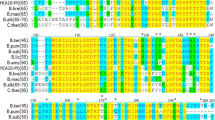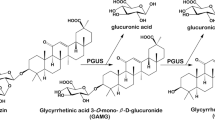Abstract
β-Glucosidase plays key role in the saccharification of cellulosic biomass. The use of β-glucosidase would benefit from improvements in its thermostability in some industrial applications. In this work, two rational computer-aided strategies were devised to enhance the thermostability of a highly active β-glucosidase from Penicillium piceum H16. Single-point mutants were proposed based on the proline theory. The effects of the mutation on protein stability were further predicted using molecular dynamics (MD) simulations. The optimal single mutant, G305P, was found to provide a 20.0 % improvement in thermostability. Then computer-assisted virtual saturated mutation was first used to select the optimal triple mutations which would further increase the thermostability of β-glucosidase by the Calculate Mutation Energy/Stability module of Discovery Studio (DS) 4.0. The triple mutant, S507F/Q512W/S514W, provided a 46.3 % improvement in thermostability. A detailed structural analysis showed that the additional hydrophobic interactions played decisive roles in the improvement in thermostability, and the use of mutants with enhanced stability may benefit formulation of more effective enzyme cocktails for lignocellulosic bioconversion.





Similar content being viewed by others
References
Liu W, Hong J, Bevan DR, Zhang YHP (2009) Fast identification of thermostable beta-glucosidase mutants on cellobiose by a novel combinatorial selection/screening approach. Biotechnol Bioeng 103:1087–1094
Zong Z, Ma L, Liang Y, Zhang D, Yang Z, Chen S (2014) Interaction mechanism between polyethylene glycol (PEG) and cellulase during hydrolysis of lignocellulose. Bioenerg Res. doi:10.1007/s12155-014-9516-7
Zhang M, Ouyang J, Liu B, Yu H, Jiang T, Cai C et al (2013) Comparison of hydrolysis efficiency and enzyme adsorption of three different cellulosic materials in the presence of poly (ethylene glycol). Bioenerg Res 6:1252–1259
Eckard AD, Muthukumarappan K, Gibbons W (2012) Pretreatment of extruded corn stover with polyethylene glycol to enhance enzymatic hydrolysis: optimization, kinetics, and mechanism of action. Bioenerg Res 5:424–438
Yi ZL, Zhang SB, Pei XQ, Wu ZL (2013) Design of mutants for enhanced thermostability of β-glycosidase BglY from Thermus thermophilus. Bioresour Technol 129:629–633
Pei XQ, Yi ZL, Tang CG, Wu ZL (2011) Three amino acid changes contribute markedly to the thermostability of β-glucosidase BglC from Thermobifida fusca. Bioresour Technol 102:3337–3342
Brethauer S, Wyman CE (2010) Review: continuous hydrolysis and fermentation for cellulosic ethanol production. Bioresour Technol 101:4862–4874
Kosugi A, Arai T, Doi RH (2006) Degradation of cellulosome-produced cello-oligosaccharides by an extracellular non-cellulosomal β-glucan glucohydrolase, BglA, from Clostridium cellulovorans. Biochem Bioph Res Co 349:20–23
Wu I, Arnold FH (2013) Engineered thermostable fungal Cel6A and Cel7A cellobiohydrolases hydrolyze cellulose efficiently at elevated temperatures. Biotechnol Bioeng 110:1874–1883
Anbar M, Gul O, Lamed R, Sezerman UO, Bayer EA (2012) Improved thermostability of Clostridium thermocellum endoglucanase Cel8A by using consensus-guided mutagenesis. Appl Environ Microb (AEM) 78:3458–3464
Talakad JC, Wilderman PR, Davydov DR, Kumar S, Halpert JR (2010) Rational engineering of cytochromes P450 2B6 and 2B11 for enhanced stability: insights into structural importance of residue 334. Arch Biochem Biophys 494:151–158
Han ZL, Han SY, Zheng SP, Lin Y (2009) Enhancing thermostability of a Rhizomucor miehei lipase by engineering a disulfide bond and displaying on the yeast cell surface. Appl Microbiol Biot 85:117–126
Suzuki Y, Hatagaki K, Oda H (1991) A hyperthermostable pullulanase produced by an extreme thermophile, Bacillus flavocaldarius KP 1228, and evidence for the proline theory of increasing protein thermostability. Appl Microbiol Biot 34:707–714
Schultz DA, Friedman AM, White MA, Fox RO (2005) The crystal structure of the cis-proline to glycine variant (P114G) of ribonuclease A. Protein Sci 14:2862–2870
Vieille C, Zeikus GJ (2001) Hyperthermophilic enzymes: sources, uses, and molecular mechanisms for thermostability. Microbiol Mol Biol R 65:1–43
Tian J, Wang P, Gao S, Chu X, Wu N, Fan Y (2010) Enhanced thermostability of methyl parathion hydrolase from Ochrobactrum sp. M231 by rational engineering of a glycine to proline mutation. FEBS J 277:4901–4908
Lee HL, Chang CK, Jeng WY, Wang AHJ, Liang PH (2012) Mutations in the substrate entrance region of β-glucosidase from Trichoderma reesei improve enzyme activity and thermostability. Protein Eng Des Sel 25:733–740
Lima MA, Oliveira-Neto M, Kadowaki MAS, Rosseto FR, Prates ET et al (2013) Aspergillus niger β-glucosidase has a cellulase-like tadpole molecular shape: insights into glycoside hydrolase family 3 (GH3) β-glucosidase structure and function. J Biol Chem 288:32991–33005
An Y, Ji J, Wu W, Lv A, Huang R, Wei Y (2005) A rapid and efficient method for multiple-site mutagenesis with a modified overlap extension PCR. Appl Microbiol Biot 68:774–778
Ho SN, Hunt HD, Horton RM, Pullen JK, Pease LR (1989) Site-directed mutagenesis by overlap extension using the polymerase chain reaction. Gene 77:51–59
Chu XY, Tian J, Wu NF, Fan YL (2010) An intramolecular disulfide bond is required for the thermostability of methyl parathion hydrolase, OPHC2. Appl Microbiol Biot 88:125–131
Cui D, Zhang L, Yao Z, Liu X, Lin J, Yuan YA et al (2013) Computational design of short-chain dehydrogenase Gox2181 for altered coenzyme specificity. J Biotechnol 167:386–392
Fujiwara R, Nakajima M, Yamamoto T, Nagao H, Yokoi T (2009) In silico and in vitro approaches to elucidate the thermal stability of human UDP-glucuronosyltransferase (UGT) 1A9. Drug Metab Pharmacok 24:235–244
Zhang ZG, Yi ZL, Pei XQ, Wu ZL (2010) Improving the thermostability of Geobacillus stearothermophilus xylanase XT6 by directed evolution and site-directed mutagenesis. Bioresour Technol 101:9272–9278
Vieille C, Gregory ZJ (1996) Thermozymes: identifying molecular determinants of protein structural and functional stability. Trends Biotechnol 14:183–190
Acknowledgments
This work was supported by grants from the National High Technology Research and Development Program of China (863 Program) (No. 2012AA101807, 2014AA021906) and the Key Technology R&D program of Tianjin Municipal Science and Technology Commission (No. 13ZCZDSY05500), National Natural Science Foundation of China for the Youth (21406260).
Author information
Authors and Affiliations
Corresponding author
Rights and permissions
About this article
Cite this article
Zong, Z., Gao, L., Cai, W. et al. Computer-Assisted Rational Modifications to Improve the Thermostability of β-Glucosidase from Penicillium piceum H16. Bioenerg. Res. 8, 1384–1390 (2015). https://doi.org/10.1007/s12155-015-9603-4
Published:
Issue Date:
DOI: https://doi.org/10.1007/s12155-015-9603-4




